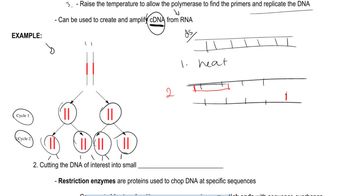Table of contents
- 1. Introduction to Genetics51m
- 2. Mendel's Laws of Inheritance3h 37m
- 3. Extensions to Mendelian Inheritance2h 41m
- 4. Genetic Mapping and Linkage2h 28m
- 5. Genetics of Bacteria and Viruses1h 21m
- 6. Chromosomal Variation1h 48m
- 7. DNA and Chromosome Structure56m
- 8. DNA Replication1h 10m
- 9. Mitosis and Meiosis1h 34m
- 10. Transcription1h 0m
- 11. Translation58m
- 12. Gene Regulation in Prokaryotes1h 19m
- 13. Gene Regulation in Eukaryotes44m
- 14. Genetic Control of Development44m
- 15. Genomes and Genomics1h 50m
- 16. Transposable Elements47m
- 17. Mutation, Repair, and Recombination1h 6m
- 18. Molecular Genetic Tools19m
- 19. Cancer Genetics29m
- 20. Quantitative Genetics1h 26m
- 21. Population Genetics50m
- 22. Evolutionary Genetics29m
18. Molecular Genetic Tools
Genetic Cloning
Problem 20b
Textbook Question
We usually think of enzymes as being most active at around 37°C, yet in PCR the DNA polymerase is subjected to multiple exposures of relatively high temperatures and seems to function appropriately at 65–75°C. What is special about the DNA polymerase typically used in PCR?
 Verified step by step guidance
Verified step by step guidance1
Understand that PCR (Polymerase Chain Reaction) involves repeated cycles of heating and cooling to denature DNA, anneal primers, and extend the DNA strands.
Recognize that typical enzymes denature at high temperatures, losing their functional shape and activity.
Identify that the DNA polymerase used in PCR is derived from thermophilic bacteria, such as *Thermus aquaticus*, which naturally live in hot environments like hot springs.
Acknowledge that this DNA polymerase, known as Taq polymerase, is thermostable, meaning it can withstand the high temperatures used in PCR without denaturing.
Conclude that the thermostability of Taq polymerase allows it to remain active and functional during the high-temperature cycles of PCR, enabling efficient DNA replication.
Recommended similar problem, with video answer:
 Verified Solution
Verified SolutionThis video solution was recommended by our tutors as helpful for the problem above
Video duration:
2mPlay a video:
Was this helpful?
Key Concepts
Here are the essential concepts you must grasp in order to answer the question correctly.
Thermostability of DNA Polymerase
DNA polymerases used in PCR, such as Taq polymerase, are derived from thermophilic organisms, which thrive in high-temperature environments. This adaptation allows them to maintain their structural integrity and enzymatic activity at elevated temperatures, typically between 65–75°C, which is essential for the denaturation and annealing steps in PCR.
Recommended video:
Guided course

DNA Proofreading
Polymerase Chain Reaction (PCR)
PCR is a molecular biology technique used to amplify specific DNA sequences. It involves repeated cycles of denaturation, annealing, and extension, where the DNA polymerase synthesizes new DNA strands. The ability of the polymerase to withstand high temperatures is crucial for the efficiency and specificity of the amplification process.
Recommended video:
Guided course

Genetic Cloning
Enzyme Activity and Temperature
Enzymes generally exhibit optimal activity at specific temperatures, with most human enzymes functioning best around 37°C. However, the activity of enzymes can vary with temperature, as higher temperatures can increase reaction rates up to a point, beyond which denaturation occurs. Thermostable enzymes, like those used in PCR, are designed to remain active and stable at higher temperatures, allowing for effective DNA synthesis during the PCR process.
Recommended video:
Guided course

Mutations and Phenotypes

 7:43m
7:43mWatch next
Master Genetic Cloning with a bite sized video explanation from Kylia Goodner
Start learningRelated Videos
Related Practice

